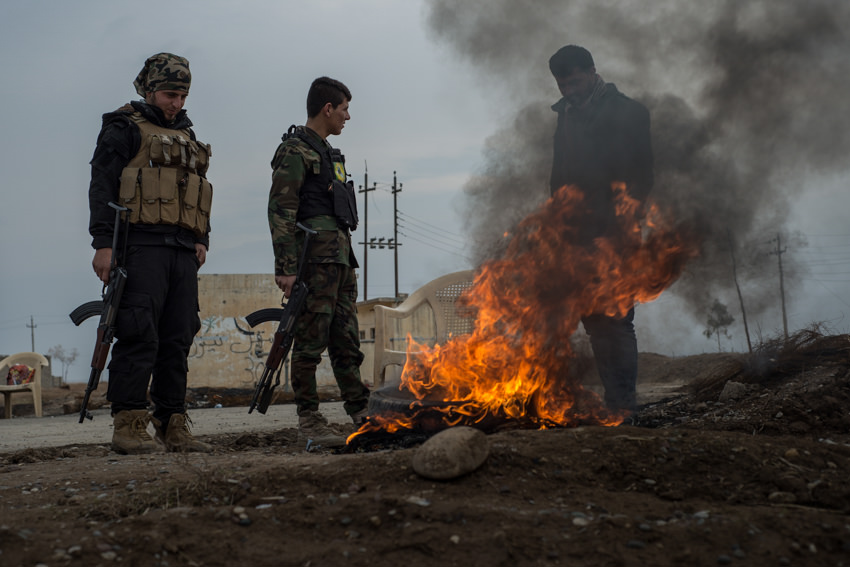
Taking Creative Risks: Freelance Photographer in Conflict Zones
A career as an uncelebrated photographer in the conflict photojournalist industry is not easy, and being a freelancer doesn’t help much either. But, it’s helped me recognize that struggling to level up your photography, because of the hard conditions of the market, is the best learning process I have ever experienced. Better than any school I have attended. Sure, it’s exhausting, and many give up along the way; paying for a career that doesn’t return a huge investment, at least in the economic way.
I have been photographing as a professional for almost nine years, but I guess that title doesn’t apply in the same way – we are never the same professionals today as when we first started. Though I had covered stories of smugglers in Colombia and illegal mining in Perú, it wasn’t until 2014, in Ukraine, when I covered the war for national media for the first time.
Getting experience in a war zone is not easy; neither is understanding what a photo agency wants from you, or realizing that, perhaps, the best story is not what they want. You must learn the hard way to work through different battles.
As a freelancer I take care of everything myself – the investment to go to a conflict zone, looking for my contacts, my stories, etc. I not only cover news as a photojournalist, I write and film as well. With all of this at play, I have to be a portable media station, which isn’t easy, so creating an efficient workflow process is necessary for survival.
Because I’m covering news, finding the front line is always top on my list. Still, it’s difficult to compete with big media, like CNN or BBC, who have huge economic and material resources at their disposal. These resources allow them to be on the front lines longer and also pay the expensive fees of fixers – someone who arranges transportation to hot zones and can serve as a translator; basically, someone who fixes your problems. So, as a solution for my lack of resources, I go look for human stories on the second line (the consequences of the war).
A good picture is a good picture, but that doesn’t mean it will always sell. Understanding what an industry wants involves a learning curve. Today, you need dramatic photos, but not too dramatic – viewers will look away and stop reading the article. The photo takes you to the captions and the captions to read the article, right?
When I am looking for stories or photos in a conflict zone I am responsible for my own security. Keeping an eye on my surroundings sometimes takes me away from focusing on my photography, but with time you normalize some activities and such awareness helps you to understand that the picture could be anywhere, so it’s important to remain sensitive; at least this is my personal way. I try to not hesitate to take the photo, but I always consider if taking the next one might be pushing it too much.
We look for work in places where people struggle to survive and that goes against human nature. While people are running away from the front lines, I am running toward them to photograph.
Being humble, and understanding you are far from being the best, is a great source of inspiration. The industry does not purchase normal or good photos. They only buy excellent photos. And there are always great photographers out there, sometimes there are more photojournalists in the trenches than soldiers.
Stress is always present, but, like fear, the important thing depends on how you manage it. We look for work in places where people struggle to survive and that goes against human nature. While people are running away from the front lines, I am running toward them to photograph. Breaking news not only looks for the front line story, but also what is happening behind it. Going there provides an excellent opportunity to slow down the stress and slow down your photography. If you want to tell your story in a more profound way, get to know your subject and really think about the photo you’re taking. For me being with people always works. Humans are the source of emotion and there is not a better picture than one that contains both action and emotion.
Of course, this work is not only exciting and adventurous, but like being part of history. We document it, but we are also a part of it.
In December, I was covering the Mosul Offensive during Christmas. I was not able to get to the front line, just within five kilometers or so. My photography was not dramatic enough, as my international photo agency told me months later when I asked for a sales report. So, lesson learned. You always need to come up with a Plan B – a business plan in a war zone and a professional one. In my case, I was photographing longer stories with deeper roots, like the Christmas of religious minorities that became refugees in their own country after being persecuted by the Islamic State. In terms of photography, the inspiration and creativity comes with a plan, learning, and many hours of shooting.
In a war zone you work 24/7; you shoot, edit, rest, manage your info and contacts, sell your work, email people, take care of your security, get shelter and food. Like my mom says, I am not very intelligent but I rely on hard work and that is the secret of my improvements in photography.
Of course, this work is not only exciting or adventurous, but like being part of history. We document it, but we are also a part of it.
You can find more of Felipe’s work on his website.
Editor’s Note: This article was edited from its original version with permission of the author, as English is not his native language.
















